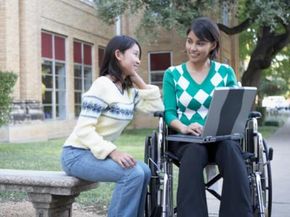Students with disabilities have a lot to think about when it comes to planning for college. For one student, a campus that doesn't require a lot of walking on his or her prosthetic leg might be a major concern, while another student might be interested in the school's adaptive technology labs [source: University of Minnesota, Totty]. According to the National Center for Education Statistics, an estimated 11 percent of undergraduates reported having a disability between 2003 and 2004 [source: U.S. Department of Education].
Along with these specific concerns, students with disabilities have many of the same concerns that other students have when planning for college, such as studying for the SATs, filling out applications and financing the college experience. According to the National Center for Education Statistics (NCES), the average price for undergraduate tuition, room and board at a public institution for the 2007-2008 academic year was $11,578. For a private education, it was $29,915 [source: U.S. Department of Education].
Advertisement
While college tuition and educational expenses may seem daunting, there are financial aid opportunities for students looking to further their educations. According to a National Center for Education Statistics study, in 2007-2008, 66 percent of undergraduates received some financial aid to help with educational expenses [source: U.S. Department of Education]. Many of the postsecondary financial aid opportunities are open to all students, yet there are many that are specifically meant for students with disabilities.
In this article, we'll review the four main types of financial aid -- loans, grants, scholarships and work-study -- focusing on when there are special opportunities or concerns for students with disabilities. First, we'll take a look at loans.
Advertisement





